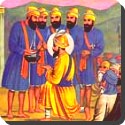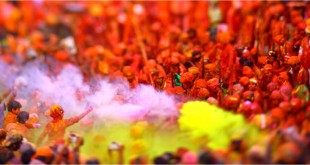 The Panj Piare, name given to the five Sikhs, Bhai Daya Singh, Bhai Dharam Singh, Bhai Himmat Singh, Bhai Mohkam Singh and Bhai Sahib Singh, who were so designated by Guru Gobind Singh at the historic divan at Anandpur Sahib on 30 March 1699 and who formed the nucleus of the Khalsa as the first batch to receive at his hands khanda di Pahul, i.e. rites of the two-edged sword.
The Panj Piare, name given to the five Sikhs, Bhai Daya Singh, Bhai Dharam Singh, Bhai Himmat Singh, Bhai Mohkam Singh and Bhai Sahib Singh, who were so designated by Guru Gobind Singh at the historic divan at Anandpur Sahib on 30 March 1699 and who formed the nucleus of the Khalsa as the first batch to receive at his hands khanda di Pahul, i.e. rites of the two-edged sword.
In Sikh theology, as in the Indian classical tradition generally, panj or panch, the numeral five, has a special significance. Guru Nanak in Japji refers to five khands, i.e. stages or steps in spiritual development, and calls a spiritually awakened person a panch. The ancient Indian socio-political institution panchayat meant a council of five elders. Something like an inner council of five existed even in the time of the earlier Gurus: five Sikhs accompanied Guru Arjan on his last journey to Lahore; the five were each given 100 armed Sikhs to command by his successor, Guru Hargobind; Guru Tegh Bahadur, set out on his journey to Delhi to court execution attended by five Sikhs.
 Kids Portal For Parents India Kids Network
Kids Portal For Parents India Kids Network






